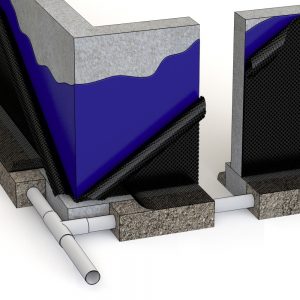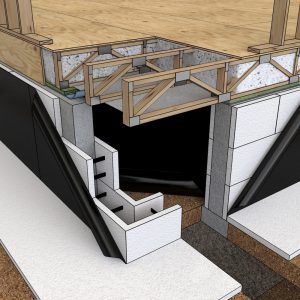Dampproofing and Waterproofing for Foundations
For basements and crawl spaces, install dampproofing, waterproofing, capillary breaks, insulation, and drains as soon as possible so that rain during construction doesn’t create moisture problems in the new home.
Dampproofing is a sprayed or rolled-on vapor retarder that provides the minimal protection from water vapor needed for dry soils. Its main use is for application to crawl-space foundations.
Waterproofing is a thick membrane (40-60 mils) that stops almost all water vapor and liquid water transmission through the foundation walls. It’s best to waterproof any foundation wall that experiences wet soil for even part of the year instead of dampproofing it. Basements are probable “occupied spaces” defined in the International Residential Code (IRC) requiring waterproofing in the IRC.
Dampproofing materials include common spray bituminous materials that are thinned by a solvent or heated to make them sprayable or rollable. These sprayed or rolled-on membranes are seldom more than 10 mils thick.
Waterproofing: Often Worth the Extra Cost
Waterproofing is considerably more expensive than dampproofing, but necessary to avoid home moisture problems when the soil is wet or when the water table is high. Waterproofing materials are vapor barriers and water barriers. They include the following.
- Water-based sprayed on, troweled-on, or rolled-on rubber membrane (30-60 mils).
- Solvent-based sprayed on, troweled-on, or rolled-on membrane (30-60 mils).
- Peel and stick composite membranes (60 mils) protected by cladding, soil, or foam insulation.
- 10-mil reinforced polyethylene.
Foundation Drainage
Smart homebuilders in regions that receive more than 30 inches of annual rainfall install drainage systems with their conventional foundations. These drainage systems include gravel out beyond the footing with a perforated drain pipe embedded in the gravel and sloped toward a daylight drain or a French drain.
Water drainage along the foundation wall may be facilitated by the following.
- A dimpled plastic waterproofing membrane on the exterior of the foundation wall that aids water in draining on either side of this material.
- Install fiberglass or rock-wool board designed to both drain water through it and to provide insulation.
Homes in drier climates don’t usually need such drainage systems.
Protecting Above-Grade Foundation Insulation

Liquid-applied waterproofing, a dimpled membrane, and a drainage system protect a foundation in a wet climate.
Above-grade exterior insulation must be covered, coated, or flashed to protect the fragile insulation from water, ice and the sun’s ultraviolet rays. Cover rigid foundation insulation at least 6 inches below grade and 6 inches above grade with a protective layer, for example.
- Peel-and-stick composite membranes (60 mils) designed to be uncovered at grade that must be resistant to water, ice, UV radiation and mechanical damage.
- Polyvinyl chloride or fiberglass sheeting designed for use below grade.
- Various types of parging materials, designed for application below grade, troweled onto the foam.
- Flexible metal or plastic flashing material such as galvanized steel, aluminum, painted-steel coil stock, or vinyl plastic coil stock adhered to the foam with a foam-compatible adhesive.

